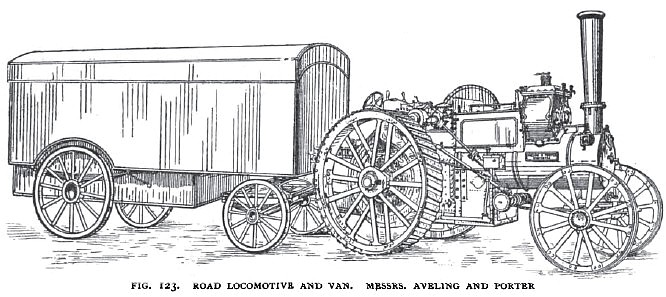Image
|
Title: |
1904 Article-Aveling & Porter, Steam Road Locomotive & Van |
|
Source: |
English and American Steam Carriages and Traction Engines 1904 pg 191 |
|
Insert Date: |
8/15/2011 10:07:24 AM |
Messrs. Aveling and Porter have manufactured a large number of road locomotives for all manner of purposes. They have been favored with orders from several European Governments for a number of quick speed road locomotives for military purposes—the transport of troops and materials. As these road engines and trains are suitable for passenger service, and have been employed in a similar capacity, a few particulars of results achieved may not be without interest. It is twenty-five years since Messrs. Aveling and Porter built the steam sapper No. 1, when a committee of the Royal Engineers made a thorough trial of it. From that time to the present no adverse report has ever been made by the authorities in charge. Experiments were made during the end of 1893 with some of these steam sappers in Paris, when a speed of twelve miles an hour was reached on ordinary roads.
Lieutenant-Colonel Templer says: "At present a train of wagons can, on the best roads, only traverse fifteen to twenty miles a day, while a traction engine would in the same time reel off sixty to seventy-five miles a day."* Road locomotives are used in the Italian Army, and by the Swiss Government. In an official report on the employment of road engines in the Russian Army it is stated: "The road engines, although only a part of them were employed, did not only completely reimburse their purchase money and the cost of maintenance, but brought an actual profit. The road locomotives have received in the military department the right of citizenship, and will, there is no doubt, render great services to that department in future." "During the Berkshire maneuvers of 1893, eight steam sappers were em-
ployed in taking stores and material to Uffington, Idstone, Liddington, and different rest camps en route, being a total tonnage of 356 tons, a distance of 150 miles, and although the engines were of different patterns and age, this service was accomplished without accident & and at small cost, which I venture to say fully proves that steam transport by road locomotives for the army and reserve forces would render most valuable service, both in peace and war, and effect an enormous saving to the country. Lieut.-Colonel Templer goes on to say: "The steam horse consumes only cheap coal or wood, while animal muscles must be renewed with expensive hay and oats. At the halt the engine ceases to require fuel and water, whereas horses require forage and water in the same quantity as when on the march. When the engine does not work it does not eat, and is costing nothing. Again, the horses would be very much harassed with a continuous march, whereas the capabilities of the steam locomotives are, at least, an average of fifty miles per day, for month after month. The steam sapper 'Queen' came from Chatham to Aldershot, viz. seventy-two miles, in twenty-six hours, and went to its regular work the next morning." It is interesting to note that the modern road locomotive is being advantageously used for many purposes, and is equally successful when applied to the requirements of the army. Some of these road trains are illustrated in LieutenantColonel Templer's pamphlet. A compound traction engine drawing a food van is reproduced by Fig. 123. Messrs. Aveling and Porter's spring arrangement will be illustrated in due course. |
|
 1904 Aveling & Porter, Steam Road Locomotive & Van
1904 Aveling & Porter, Steam Road Locomotive & Van
|
|
|
|